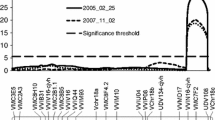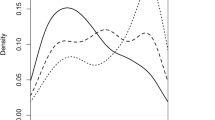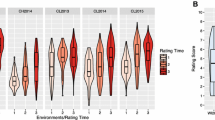Abstract
Key message
Host resistance in WI7120 cucumber to prevailing downy mildew pathogen field populations is conferred by two major-effect, one moderate-effect and two minor-effect QTL.
Abstract
Downy mildew (DM) caused by the obligate oomycete Pseudoperonospora cubensis is the most devastating fungal disease of cucumber worldwide. The molecular mechanism of DM resistance in cucumber is poorly understood, and use of marker-assisted breeding for DM resistance is not widely available. Here, we reported QTL mapping results for DM resistance with 243 F2:3 families from the cross between DM-resistant inbred line WI7120 (PI 330628) and susceptible ‘9930’. A linkage map was developed with 348 SSR and SNP markers. Phenotyping of DM inoculation responses were conducted in four field trails in 2 years at three locations. Four QTL, dm2.1, dm4.1, dm5.1, and dm6.1 were consistently and reliably detected across at least three of the four environments which together could explain 62–76 % phenotypic variations (R 2). Among them, dm4.1 and dm5.1 were major-effect QTL (R 2 = 15–30 %) with only additive effects; dm2.1 (R 2 = 5–15 %) and dm6.1 (R 2 = 4–8 %) had moderate and minor effects, respectively. Epistatic effects were detected for dm2.1 and dm6.1 with both dm4.1 and dm5.1. One additional minor-effect QTL, dm6.2 (R 2 = 3–5 %) was only detectable with the chlorosis rating criterion. All alleles contributing to DM resistance were from WI7120. This study revealed two novel QTL for DM resistance and the unique genetic architecture of DM resistance in WI7120 conferring high level resistance to prevailing DM populations in multiple countries. The effects of disease rating scales, rating time and criteria, population size in phenotyping DM resistance on the power of QTL detection, and the use of DM resistance in WI7120 in cucumber breeding were discussed.



Similar content being viewed by others
References
Angelov D (1982) Relation of various samples of cucumbers to the mildew disease, Pseudoperonospora cubensis (Berk. & Curt.) Rostow; in Rep 2nd. Natl Symp Plant Immun (Plovdiv) 3:99–105
Arends D, Prins P, Jansen RC, Broman KW (2010) R/qtl: high-throughput multiple QTL mapping. Bioinformatics 26:2990–2992
Bai Z, Yuan X, Cai R, Liu L, He H, Zhou H, Pan J (2008) QTL analysis of downy mildew resistance in cucumber. Prog Nat Sci 18:706–710 (in Chinese)
Barnes WC (1948) The performance of Palmetto, a new downy mildew-resistant cucumber variety. Proc Amer Soc Hort Sci 51:437–444
Barnes WC, Epps WM (1954) An unreported type of resistance to cucumber downy mildew. Plant Dis Report 38:409–415
Broman KW, Wu H, Sen S, Churchill GA (2003) R/qtl: QTL mapping in experimental crosses. Bioinformatics 19:889–890
Call AD, Criswell AD, Wehner TC et al (2012a) Resistance of cucumber cultivars to a new strain of cucurbit downy mildew. HortSci 47:171–178
Call AD, Criswell AD, Wehner TC et al (2012b) Screening cucumber for resistance to downy mildew caused by Pseudoperonospora cubensis (Berk. and Curt.) Rostov. Crop Sci 52:577–592
Cavagnaro PF, Senalik DA, Yang LM, Simon PW, Harkins TT, Kodira CD, Huang SW, Weng Y (2010) Genome-wide characterization of simple sequence repeats in cucumber (Cucumis sativus L.). BMC Genom 11:569
Chen T, Cohen Y (2013) Isolate-dependent inheritance of resistance to downy mildew in cucumber (Abstracts of Presentations at the 34th Congress of the Israeli Phytopathological Society). Phytoparasitica 41:462
Cohen Y, Rotem J (1971) Rate of lesion development in relation to sporulating potential of Pseudoperonospora cubensis in cucumbers. Phytopathol 61:265–268
Cohen Y, Rubin AE, Galperin M, Ploch S, Runge F, Thines M (2014) Seed transmission of Pseudoperonospora cubensis. PLoS One 9:e109766
Cohen Y, Van den Langenberg KM, Wehner TC, Ojiambo PS, Hausbeck M, Quesada-Ocampo LM, Lebeda A, Sierotzki H, Gisi U (2015) Resurgence of Pseudoperonospora cubensis: the causal agent of cucurbit downy mildew. Phytopathol 105:998–1012
Criswell AD, Wehner TC, Klosinska U, Kozik E (2008) Use of sporulation and other leaf and vine traits for evaluation of resistance to downy mildew in cucumber. In: Pitrat M (ed) Proc Cucurbitaceae. INRA, Avignon, May 21–24th, 2008
Ding G, Qin Z, Zhou X, Fan J (2007) RAPD and SCAR markers linked to downy mildew resistance genes in cucumber. Acta Botanica Boreali-Occidentalia Sinica 27:1747–1751 (in Chinese)
Epps WM, Barnes WC (1952) The increased susceptibility of the palmetto cucumber to downy mildew in South Carolina. Plant Dis Rept 36:14–15
Fanourakis NE, Simon PW (1987) Analysis of genetic linkage in the cucumber. J Hered 78:238–242
Gilmour AR, Gogel BJ, Cullis BR, Thompson R (2009) ASReml user guide release 3.0
Hartung K, Piepho HP (2007) Are ordinal rating scales better than percent ratings? a statistical and “psychological” view. Euphytica 155:15–26
He X, Li YH, Pandey S, Yandell BS, Pathak M, Weng Y (2013) QTL mapping of powdery mildew resistance in WI 2757 cucumber (Cucumis sativus L.). Theor Appl Genet 126:2149–2161
Holdsworth WL, Summers CF, Glos M et al (2014) Development of downy mildew-resistant cucumbers for late-season production in the northeastern United States. HortSci 49:10–17
Holmes GJ, Main CE, Zeever ZT (2004) Cucurbit downy mildew: a unique pathosystem for disease forecasting. In: Spencer-Phillips PTN, Jeger M (eds) Advances in Downy Mildew Research. Kluwer Academic Publishers, Dordercht, pp 69–80
Holmes GJ, Wehner TC, Thornton A (2006) An old enemy re-emerges. American Vegetable Grower, pp 14–15
Horejsi T, Staub JE, Thomas C (2000) Linkage of random amplified polymorphic DNA markers to downy mildew resistance in cucumber (Cucumis sativus L.). Euphytica 115:105–113
Innark P, Ratanachan T, Khanobdee C, Samipak S, Jantasuriyarat C (2014) Downy mildew resistant/susceptible cucumber germplasm (Cucumis sativus L.) genetic diversity assessment using ISSR markers. Crop Prot 60:56–61
Jenkins SF Jr (1942) Downy mildew resistances in cucumber. J Hered 33:35–39
Jenkins SF Jr (1946) Studies on the inheritance of downy mildew resistance and of other characters in cucumbers. J Hered 37:261–271
Kennard WC, Poetter K, Dijkhuizen A, Meglic V, Staub JE, Havey MJ (1994) Linkages among RFLP, RAPD, isozyme, disease-resistance, and morphological markers in narrow and wide crosses of cucumber. Theor Appl Genet 89:42–48
Kozik EU, Klosińska U, Call AD, Wehner TC (2013) Heritability and genetic variance estimates for resistance to downy mildew in cucumber accession Ames 2354. Crop Sci 53:177–182
Lebeda A (1999) Pseudoperonospora cubensis on Cucumis and Cucurbita spp: resistance breeding aspects. Proc 1st Intl Symp Cucurbits Acta Hort 492:363–370
Lebeda A, Urban J (2007) Temporal changes in pathogenicity and fungicide resistance in Pseudoperonospora cubensis populations. Acta Hortic 731:327–336
Lebeda A, Pavelkova J, Sedlakova B, Urban J (2013) Structure and temporal shifts in virulence of Pseudoperonospora cubensis populations in the Czech Republic. Plant Pathol 62:336–345
Li Z, Zhang Z, Yan P, Huang S, Fei Z, Lin K (2011) RNA-Seq improves annotation of protein-coding genes in the cucumber genome. BMC Genom 12:540
Li Y, Wen C, Weng Y (2013) Fine mapping of the pleiotropic locus B for black spine and orange mature fruit color in cucumber identifies a 50 kb region containing a R2R3-MYB transcription factor. Theor Appl Genet 126:2187–2196
Miao H, Zhang S, Wang X et al (2011) A linkage map of cultivated cucumber (Cucumis sativus L.) with 248 microsatellite marker loci and seven genes for horticulturally important traits. Euphytica 182:167–176
Oerke E, Steiner U, Dehne H, Lindenthal M (2006) Thermal imaging of cucumber leaves affected by downy mildew and environmental conditions. J Exp Bot 57:2121–2132
Ojiambo PS, Gent DH, Quesada-Ocampo LM et al (2015) Epidemiology and population biology of Pseudoperonospora cubensis : a model system for management of downy mildews. Annu Rev Phytopathol 53:223–246
Pang X, Zhou X, Wan H, Chen J (2013) QTL mapping of downy mildew resistance in an introgression line derived from interspecific hybridization between cucumber and Cucumis hystrix. J Phytopathol 161:536–543
Petrov L, Boogert K, Sheck L, Baider A, Rubin E, Cohen Y (2000) Resistance to downy mildew, Pseudoperonospora cubensis, in cucumbers. Acta Hort (ISHS) 510:203–210
Poland J, Nelson RJ (2011) In the eye of the beholder: the effect of rater variability and different rating scales on QTL mapping. Phytopathology 101:290–298
Postman J, Volk G, Aldwinckle H (2010) Standardized plant disease evaluations will enhance resistance gene discovery. HortSci 45:1317–1320
Quesada-Ocampo LM, Granke LL, Olsen J, Gutting HC, Runge F, Thines M, Lebeda A, Hausbeck MK (2012) The genetic structure of Pseudoperonospora cubensis populations. Plant Dis 96:1459–1470
Ren Y, Zhang Z, Liu J et al (2009) An integrated genetic and cytogenetic map of the cucumber genome. PLoS One 4:e5795
Rubinstein M, Katzenellenbogen M, Eshed R, Rozen A, Katzir N, Colle M, Yang L, Grumet R, Weng Y, Sherman A, Ophir R (2015) Ultrahigh-density linkage map for cultivated cucumber (Cucumis sativus L.) using a single-nucleotide polymorphism genotyping array. PLoS One 10:e0124101
Savory EA, Granke LL, Quesada-Ocampo LM, Varbanova M, Hausbeck MK, Day B (2011) The cucurbit downy mildew pathogen Pseudoperonospora cubensis. Mol Plant Pathol 12:217–226
Szczechura W, Staniaszek M, Klosinska U, Kozik EU (2015) Molecular analysis of new sources of resistance to Pseudoperonospora cubensis (Berk. et Curt.) Rostov. in cucumber. Russian J Genet 51:974–979
van Vliet GJA, Meysing W (1974) Inheritance of resistance to Pseudoperonospora Cubensis Rost in cucumber (Cucumis Sativus L.). Euphytica 23:251–255
VandenLangenberg KM (2015) Studies on downy mildew resistance in cucumber (Cucumis sativus L.). North Carolina State University, Raleigh
Wehner TC, Shetty NV (1997) Downy mildew resistance of the cucumber germplasm collection in North Carolina field tests. Crop Sci 37:1331–1340
Xie W, Yu K, Pauls KP, Navabi A (2012) Application of image analysis in studies of quantitative disease resistance exemplified using common bacterial blight–common bean pathosystem. Phytopathology 102:434–442
Yang L, Koo DH, Li YH, Zhang XJ, Luan FS, Havey MJ, Jiang JM, Weng Y (2012) Chromosome rearrangements during domestication of cucumber as revealed by high-density genetic mapping and draft genome assembly. Plant J 71:895–906
Yang L, Li DW, Li YH, Gu XF, Huang SW, Garcia-Mas J, Weng Y (2013) A 1,681-locus consensus genetic map of cultivated cucumber including 67 NB-LRR resistance gene homolog and ten gene loci. BMC Plant Biol 13:53
Yoshioka Y, Sakata Y, Sugiyama M, Fukino N (2014) Identification of quantitative trait loci for downy mildew resistance in cucumber (Cucumis sativus L.). Euphytica 198:265–276
Zhang S, Liu MM, Miao H et al (2013) Chromosomal mapping and QTL analysis of resistance to downy mildew in Cucumis sativus. Plant Dis 97:245–251
Acknowledgments
The authors thank Kristin Haider for technical help. We are also indebted to Vittorio Stravato, and Giuseppe Carannante for help phenotyping of DM resistance in the IT2013 experiment. This research was supported by the US Department of Agriculture (USDA)-Specialty Crop Research Initiative Grant (SCRI, project # 2011-51181-30661) to YW. Names are necessary to report factually on available data; however, the USDA neither guarantees nor warrants the standard of the product, and the use of the name by USDA implies no approval of the product to the exclusion of others that may also be suitable. USDA is an equal opportunity provider and employer.
Author information
Authors and Affiliations
Corresponding author
Ethics declarations
Conflict of interest
The authors declares no conflict of interest.
Additional information
Communicated by S. Huang.
Electronic supplementary material
Below is the link to the electronic supplementary material.
Rights and permissions
About this article
Cite this article
Wang, Y., VandenLangenberg, K., Wehner, T.C. et al. QTL mapping for downy mildew resistance in cucumber inbred line WI7120 (PI 330628). Theor Appl Genet 129, 1493–1505 (2016). https://doi.org/10.1007/s00122-016-2719-x
Received:
Accepted:
Published:
Issue Date:
DOI: https://doi.org/10.1007/s00122-016-2719-x




